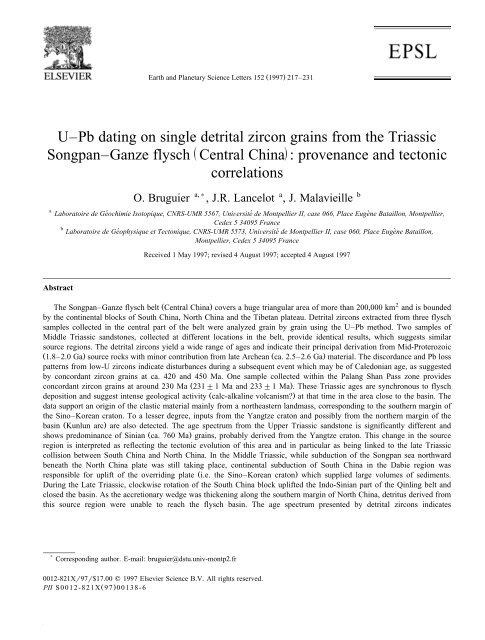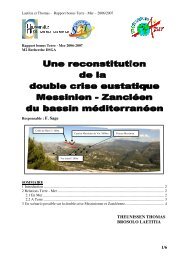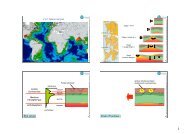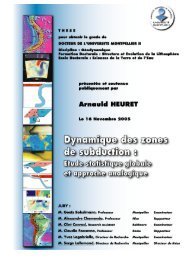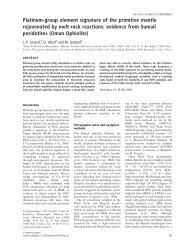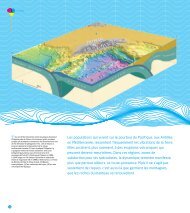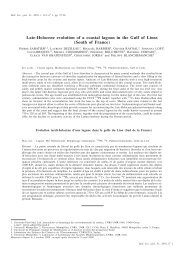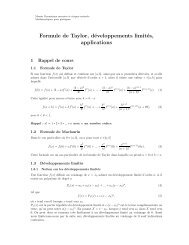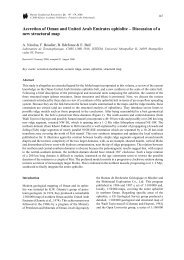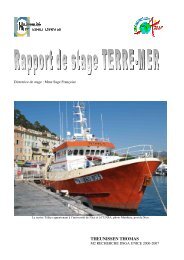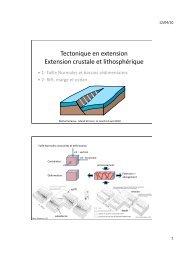Géochronologie U-Pb par ablation laser et ICP-MS (LA-ICP-MS ...
Géochronologie U-Pb par ablation laser et ICP-MS (LA-ICP-MS ...
Géochronologie U-Pb par ablation laser et ICP-MS (LA-ICP-MS ...
Create successful ePaper yourself
Turn your PDF publications into a flip-book with our unique Google optimized e-Paper software.
Ž .<br />
Earth and Plan<strong>et</strong>ary Science L<strong>et</strong>ters 152 1997 217–231<br />
U–<strong>Pb</strong> dating on single d<strong>et</strong>rital zircon grains from the Triassic<br />
Songpan–Ganze flysch ž Central China /: provenance and tectonic<br />
correlations<br />
O. Bruguier a,) , J.R. Lancelot a , J. Malavieille b<br />
a Laboratoire de Geochimie ´ Isotopique, CNRS-UMR 5567, UniÕersite´ de Montpellier II, case 066, Place Eugene ` Bataillon, Montpellier,<br />
Cedex 5 34095 France<br />
b Laboratoire de Geophysique ´ <strong>et</strong> Tectonique, CNRS-UMR 5573, UniÕersite´ de Montpellier II, case 060, Place Eugene ` Bataillon,<br />
Montpellier, Cedex 5 34095 France<br />
Received 1 May 1997; revised 4 August 1997; accepted 4 August 1997<br />
Abstract<br />
Ž .<br />
2<br />
The Songpan–Ganze flysch belt Central China covers a huge triangular area of more than 200,000 km and is bounded<br />
by the continental blocks of South China, North China and the Tib<strong>et</strong>an plateau. D<strong>et</strong>rital zircons extracted from three flysch<br />
samples collected in the central <strong>par</strong>t of the belt were analyzed grain by grain using the U–<strong>Pb</strong> m<strong>et</strong>hod. Two samples of<br />
Middle Triassic sandstones, collected at different locations in the belt, provide identical results, which suggests similar<br />
source regions. The d<strong>et</strong>rital zircons yield a wide range of ages and indicate their principal derivation from Mid-Proterozoic<br />
Ž 1.8–2.0 Ga. source rocks with minor contribution from late Archean Ž ca. 2.5–2.6 Ga.<br />
material. The discordance and <strong>Pb</strong> loss<br />
patterns from low-U zircons indicate disturbances during a subsequent event which may be of Caledonian age, as suggested<br />
by concordant zircon grains at ca. 420 and 450 Ma. One sample collected within the Palang Shan Pass zone provides<br />
concordant zircon grains at around 230 Ma Ž 231"1 Ma and 233"1 Ma .. These Triassic ages are synchronous to flysch<br />
deposition and suggest intense geological activity Ž calc-alkaline volcanism . at that time in the area close to the basin. The<br />
data support an origin of the clastic material mainly from a northeastern landmass, corresponding to the southern margin of<br />
the Sino–Korean craton. To a lesser degree, inputs from the Yangtze craton and possibly from the northern margin of the<br />
basin Ž Kunlun arc.<br />
are also d<strong>et</strong>ected. The age spectrum from the Upper Triassic sandstone is significantly different and<br />
shows predominance of Sinian Ž ca. 760 Ma.<br />
grains, probably derived from the Yangtze craton. This change in the source<br />
region is interpr<strong>et</strong>ed as reflecting the tectonic evolution of this area and in <strong>par</strong>ticular as being linked to the late Triassic<br />
collision b<strong>et</strong>ween South China and North China. In the Middle Triassic, while subduction of the Songpan sea northward<br />
beneath the North China plate was still taking place, continental subduction of South China in the Dabie region was<br />
responsible for uplift of the overriding plate Ž i.e. the Sino–Korean craton.<br />
which supplied large volumes of sediments.<br />
During the Late Triassic, clockwise rotation of the South China block uplifted the Indo-Sinian <strong>par</strong>t of the Qinling belt and<br />
closed the basin. As the accr<strong>et</strong>ionary wedge was thickening along the southern margin of North China, d<strong>et</strong>ritus derived from<br />
this source region were unable to reach the flysch basin. The age spectrum presented by d<strong>et</strong>rital zircons indicates<br />
) Corresponding author. E-mail: bruguier@dstu.univ-montp2.fr<br />
0012-821Xr97r$17.00 q 1997 Elsevier Science B.V. All rights reserved.<br />
Ž .<br />
PII S0012-821X 97 00138-6


